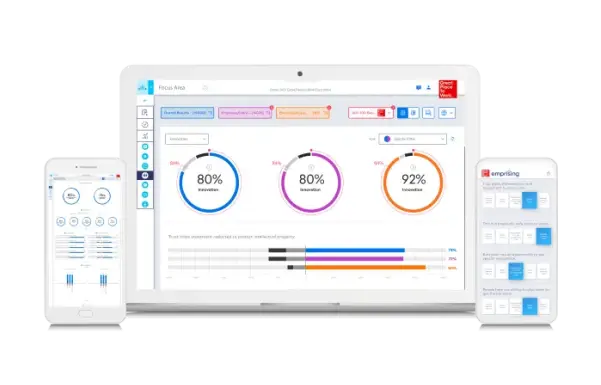
The terms leadership and management are frequently used interchangeably. While the distinction between the two may seem trivial at first glance, there’s actually a significant difference between them. Understanding this contrast will help you provide better guidance to your teams and be more effective in your role.
Understanding leadership vs. management
When it comes to understanding the difference between leadership and management, it may be helpful to think of a map. A leader is responsible for choosing a destination and the overall direction, while a manager shares the specific turns you need to make to get from Point A to Point B. Let’s explore this idea more in depth.
Leadership
As you may have deduced from the example above, leadership is about providing a high-level vision for a team – with the goal of innovating in a way that will help an organization in the long run by asking what needs to change and why. From there, leaders guide people in the right direction by providing support, inspiration, and motivation. Along the way, leaders check in to make sure everyone is aligned and on the right track, but they rarely get involved in the tactical decisions.
Management
Management’s responsibility, on the other hand, is to execute on the leader’s vision. Once the destination has been set, managers are the one who oversee the series of tactics that will get them to where they need to be. This involves assigning tasks to team members, making sure everyone is collaborating harmoniously, and ensuring they hit the appropriate deadlines to reach their short-term goals.
Playing both roles
While there’s a clear distinction between the two roles, there are times that the lines will either overlap or be blurred. In other words, certain situations will require managers to step up into more of a leadership role while others will need leaders to take on more of a managerial role. Below are a few examples of when this may be required.
Managers as leaders:
When overseeing a very large team
In the absence of or during a transition of a team leader
While providing mentorship to team members or employees
Leaders As Managers:
When taking on a direct report
In the absence of or during a transition of a key manager
While working with managers or direct reports who need additional support or more specific guidance
Why the distinction is important
Both leadership and management are important to have at every organization. Without leadership, teams would be directionless and not be united on a vision. Without management, teams wouldn’t be able to take actionable steps or complete the goals they need to achieve their vision. Let’s take a look at some real-life scenarios to see what these roles look like in action.
Scenario #1
Your organization recently went through an acquisition. While exciting, the transition is causing some friction and employee morale is low as a result. This is the right time to practice leadership. Since most of the problem stems from a lack of clarity around the shift and future direction of the company, it may be helpful to sit down with the team and explain your thinking, the type of change you intend to create, and how the company will move forward together through this transition.
Scenario #2
On the other hand, let’s say you’re confronted with a huge project that has many moving parts and a tight deadline. In this situation, you may want to put on your managerial hat. Doing so will enable you to set goals, effectively assign tasks to your team, and make sure everyone is laser-focused until the project is completed.
Regardless of your title or position, we believe there’s room to practice both management and leadership skills – depending on what the situation calls for. However, it’s important to note that – in general – the higher you move up in an organization, the more your role will focus on the leadership aspects than the managerial aspects. As long as you’re prepared for this eventual transition and still trust your managers to carry out your vision, you’ll be set up for success!
By understanding the distinction between leadership and management, you’ll be able to choose the right hat to wear depending on your team’s current needs. If you feel like you need more help developing these skills – particularly for leadership – one-on-one coaching can be a useful tool to help you hone in on the areas that you need improvement in.
About Great Place to Work®
Great Place to Work® is the Global Authority on Workplace Culture. We make it easy to survey your employees, uncover actionable insights and get recognized for your great company culture. Learn more about Great Place to Work Certification.























